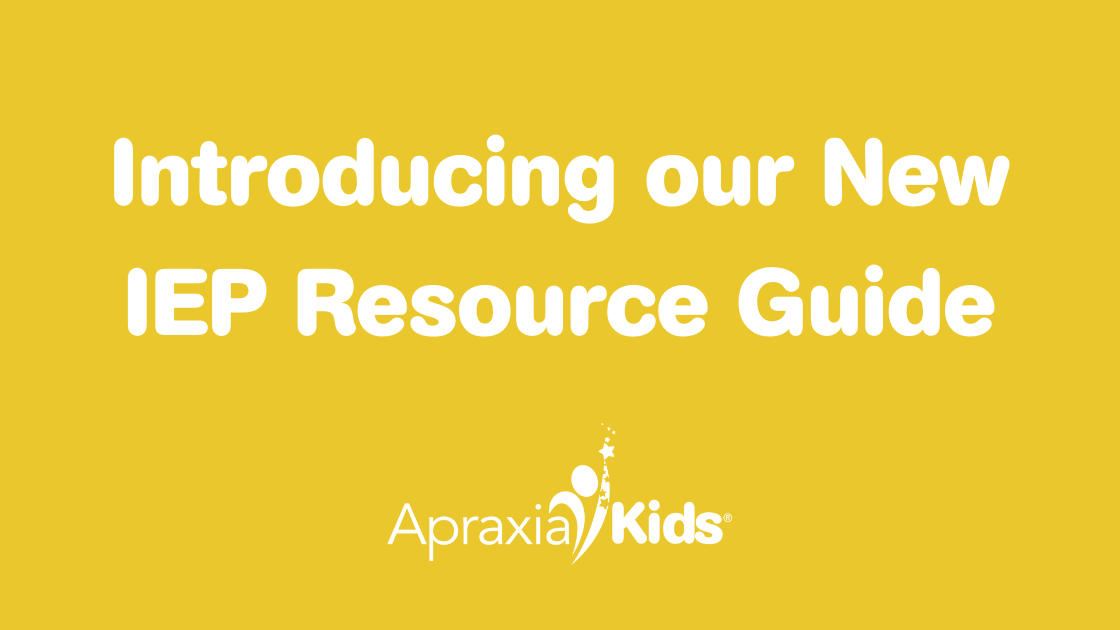
02 May Introducing our NEW IEP Resource Guide!
The world of IEPs and 504s and all of the other alphabet soup of special education can be overwhelming and very confusing! There’s tons of helpful information out there, but even that can be difficult to navigate. Apraxia Kids has compiled a BRAND NEW Resource Guide all about IEPs to help you navigate this process!
Check out the IEP Resource Guide now!
What exactly is an IEP? An Individualized Education Plan (IEP) is a written plan that spells out the specific types of help that a student will receive to be successful in school. With an IEP, your child will get individualized instruction that focuses on improving specific skills, including accommodations and modifications. It allows you to be involved in decisions that impact your child’s education and learning goals.
IEPs are a part of public education. They’re given to eligible students who attend public school (including charter schools). Private schools don’t have to offer IEPs, however, students in private school may be able to get special education through what’s known as a service plan (also called an Individual Services Plan). Even before they attend school, babies and toddlers can get services through early intervention. Once children age out of early intervention, they can get an IEP through their local public school district.
So what’s in this new IEP Resource Guide?! Let’s check it out together!
- 2 Apraxia Kids webinars FREE for the month of May!
- 5 Apraxia Kids articles on IEPs and students with apraxia
- Free brochures and printables to share with your IEP team
- Tips on preparing for your next IEP meeting
- Sample IEP accommodations specifically for apraxia
- Information on special education advocates
- Sample letter templates and tracking sheets
- Glossary of special education acronyms (lovingly called Alphabet Soup!)
- Additional articles and resources
We hope this new IEP Resource Guide helps you and your hardworking apraxia star navigate your schooling adventures a little easier!
The world of IEPs and 504s and all of the other alphabet soup of special education can be overwhelming and very confusing! There’s tons of helpful information out there, but even that can be difficult to navigate. Apraxia Kids has compiled a BRAND NEW Resource Guide all about IEPs to help you navigate this process!
Check out the IEP Resource Guide now!
What exactly is an IEP? An Individualized Education Plan (IEP) is a written plan that spells out the specific types of help that a student will receive to be successful in school. With an IEP, your child will get individualized instruction that focuses on improving specific skills, including accommodations and modifications. It allows you to be involved in decisions that impact your child’s education and learning goals.
IEPs are a part of public education. They’re given to eligible students who attend public school (including charter schools). Private schools don’t have to offer IEPs, however, students in private school may be able to get special education through what’s known as a service plan (also called an Individual Services Plan). Even before they attend school, babies and toddlers can get services through early intervention. Once children age out of early intervention, they can get an IEP through their local public school district.
So what’s in this new IEP Resource Guide?! Let’s check it out together!
- 2 Apraxia Kids webinars FREE for the month of May!
- 5 Apraxia Kids articles on IEPs and students with apraxia
- Free brochures and printables to share with your IEP team
- Tips on preparing for your next IEP meeting
- Sample IEP accommodations specifically for apraxia
- Information on special education advocates
- Sample letter templates and tracking sheets
- Glossary of special education acronyms (lovingly called Alphabet Soup!)
- Additional articles and resources
We hope this new IEP Resource Guide helps you and your hardworking apraxia star navigate your schooling adventures a little easier!
Credentials:
Hours of Operation:
Treatment locations:
Address:
,
Phone:
Email:
Overall Treatment Approach:
Percent of CAS cases:
Parent Involvement:
Community Involvement:
Professional consultation/collaboration:
Min Age Treated:
Max Age Treated:
Insurance Accepted:




